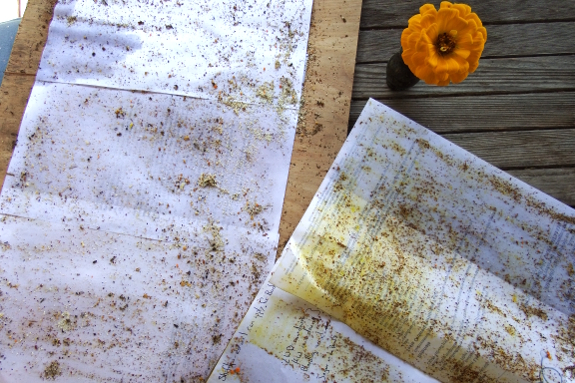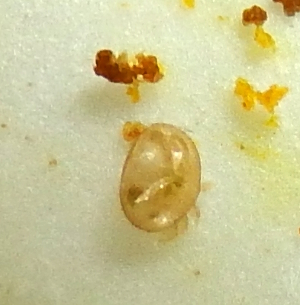
Winterizing the hive, part 2: Varroa mite count

Last week, I wrote about
step
one of winterizing our hives: checking on honey stores and feeding if
necessary. At the
same time I make my early fall hive check, I also move on to part two
of the winterization campaign: testing for varroa mites.
 I've written about how
and why to test for varroa mites with a homemade stickyboard here. This time around, our Warre
hive passed with predictably flying colors, dropping an average of only
9.3 mites per day. The bulkier Langstroth hive had quite a few more
mites, clocking in at 31.3 mites per day. (Yes, I do count even
immature specimens like the one shown to the right.)
I've written about how
and why to test for varroa mites with a homemade stickyboard here. This time around, our Warre
hive passed with predictably flying colors, dropping an average of only
9.3 mites per day. The bulkier Langstroth hive had quite a few more
mites, clocking in at 31.3 mites per day. (Yes, I do count even
immature specimens like the one shown to the right.)
In part, the Langstroth
hive's higher mite count is due to the fact there are simply more bees
present in that hive, but the infestation is still a little further
along than I'd prefer. On the other hand, the last time I used
non-chemical treatment for a borderline hive, I really regretted it ---
after being dusted
with powdered sugar,
the bees got so pissed off about the intrustion that they absconded. So
I'm going to try some rhubarb-leaf
anti-mite strips, then test again in a month to see if pest levels
are increasing or decreasing as the bees begin to slim their colony
down in time for winter.
Want more in-depth information? Browse through our books.
Or explore more posts by date or by subject.
About us: Anna Hess and Mark Hamilton spent over a decade living self-sufficiently in the mountains of Virginia before moving north to start over from scratch in the foothills of Ohio. They've experimented with permaculture, no-till gardening, trailersteading, home-based microbusinesses and much more, writing about their adventures in both blogs and books.
Want to be notified when new comments are posted on this page? Click on the RSS button after you add a comment to subscribe to the comment feed, or simply check the box beside "email replies to me" while writing your comment.
